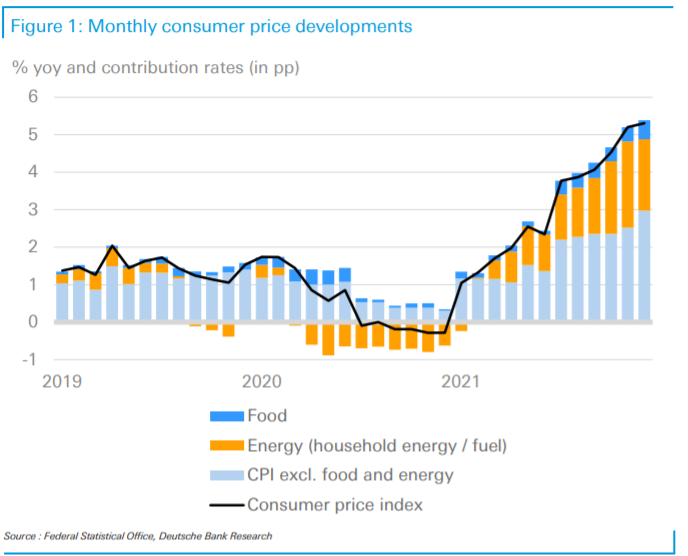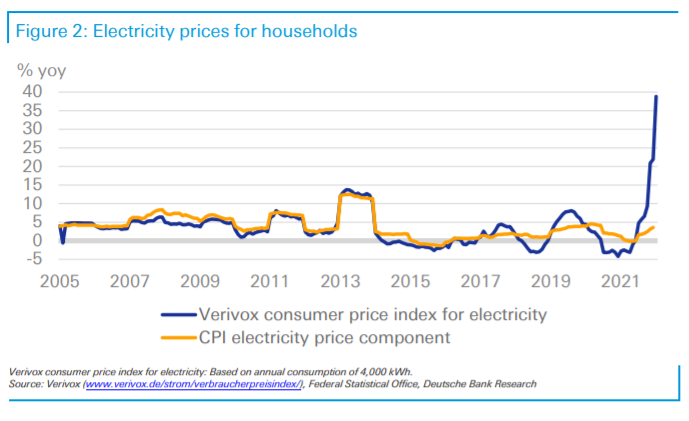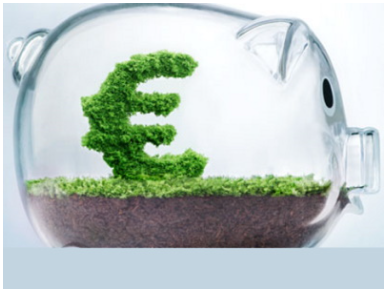Deutsche Bank har analyseret de ekstreme stigninger i energipriserne den seneste tid. Der er en lang række faktorer, der spiller ind, men forbrugerne skal vænne sig til, at prisstigningerne kan blive værre, og der vil under alle omstændigheder fortsat være høje energipriser, selv om de måske bliver lidt mindre end i dag. Det er energipriserne, der er den vigtigste faktor bag inflationen og dermed de kommende rentestigninger. Benzin og diesel er steget med 20-25 pct. det seneste år. I år vil gas- og el-priserne formentlig stige med henholdsvis 20 og 15 pct. Den grønne omstilling bliver dyr, og i omstillingsperioden vil der være mangel på olie og gas, og det vil også sætte elektricitetspriserne i vejret. Investeringerne i en grøn økonomi bliver ekstreme, og det er forbrugerne, der må betale for det. Velkommen til den grønne fremtid. Nu begynder vi at se prisen for det, alle efterspørger. Forbrugerne skal vænne sig til et helt nyt begreb – greenflation – dvs. den inflation, som skyldes de prisstigninger, der vedrører den grønne omstilling.
Energy price inflation – this time is
different
Energy prices were the main driver of consumer price inflation (CPI) in Germany in
2021. The energy price component in German CPI – comprising household energy
(electricity, gas, heating oil) as well as petrol and diesel – rose by 10.4% on average
last year, contributing more than one percentage point to the annual inflation rate
(2020: -0.5 pp).
The reasons for the sharp increase in energy prices are manifold: On
the one hand, global energy demand has increased drastically due to the
synchronised world economic recovery and higher mobility after the first corona
lockdowns in early 2020 and winter 2020/21.
On the other hand, the global energy
supply has been severely disturbed by several external shocks and market
imbalances such as extreme weather events in the US in early 2021, technical
problems at gas fields and pipelines in Europe, low filling levels for gas storage
capacity in Germany, interruptions in the global logistics sector or trade issues
between China and Australia.
What is more, climate policy measures contributed to the general price increase for
energy. In 2021, Germany introduced a new carbon levy (basically a tax) of EUR 25
per tonne of CO2 that affects heating oil, natural gas and liquid fuels. This measure
alone caused, for example, a price increase by 7.1 cent per litre of petrol and 8.0 cent
per litre diesel and heating oil, respectively, and added 0.46 cents per kWh to the
price of natural gas – a major source for heating in Germany.


The overall CO2 price effect from the country’s climate package on Germany’s 2021
inflation rate (both direct and indirect price raising effects net of any electricity price
dampening effects from the decrease in the EEG levy) were estimated to amount to
around 0.3 percentage points, according to Deutsche Bundesbank (see pages 30-
34 in the monthly report for December 2019 as well as footnote 13 on page 27 in the
monthly report for June 2020).
In 2022, the implemented increase in the carbon levy
from EUR 25 to EUR 30 per tonne of CO2 could add another 0.2 percentage points,
according to the Bundesbank. A temporary factor that has further pushed up
Germany’s inflation rate in 2021 – and hence also Germany’s CPI energy price
component – was the reintroduction of the increase in the value added tax (VAT).
The VAT effect contributed approximately more than a full percentage point to the
December 2021 inflation rate of 5.3%.
Time lag between commodity and producer prices and consumer prices
Consumer pockets are affected by higher world market prices for crude oil quite
directly at the pump. Service station operators can pass through these price
increases almost at an hourly basis. Diesel and petrol prices are currently roughly
20-25% higher than in early 2021.
Moreover, the considerable increase in Brent
crude oil prices to more than USD 85 per barrel (a seven-year high) speaks against
a fast and marked slowdown in double-digit fuel price inflation.
The worst is still to come
The worst is still to come for private households in terms of price increases
for natural gas and electricity. In 2022 as a whole, prices might increase by more
than 20% for gas on average and by more than 15% for electricity. In that case,
higher gas and electricity prices would substantially boost Germany’s inflation rate
in 2022.
Given their shares in the overall CPI basket (of 2.6% for electricity and 2.5%
for natural gas), such price hikes could on their own raise the headline rate by up to
1 pp (2021: 0.1 pp).
Greenflation
Structural factors are likely to keep energy price inflation high
A more ambitious climate and energy policy will very likely continue to raise
consumer price inflation over the medium term. Rising CO2 prices (via the national
carbon levy or the EU wide emissions trading system) will lead to a permanently
higher price trend for fossil fuels (oil/gas heating, fuels).
Moreover, it will affect costs
for electricity generation given that 43% of Germany’s total electricity generation
is based on coal and natural gas (data as of 2021). The share of fossil fuels in
electricity generation could even increase in 2022 since three nuclear power plants
went off the grid in late 2021. Overall, this weakens the widespread argument of
viewing energy price increases as temporary.
Thus, consumers could be confronted with climate policy-induced higher energy
price inflation (“greenflation”). This is because consumers have few alternatives
(heating, mobility, etc.) in the short run and therefore must carry rising energy costs.
In addition, the path towards a climate-friendly economy requires enormous
private and public investments in new infrastructure. These climate-related
investment goods compete for already limited production capacities (particularly
skilled labour shortages amid rapid population ageing), intensifying price pressures
in the capital goods, construction and craft sectors.
Already in 2021, construction
investment prices increased by more than 8% (as measured by the deflator for
construction investment activity in the overall German macro economy).













